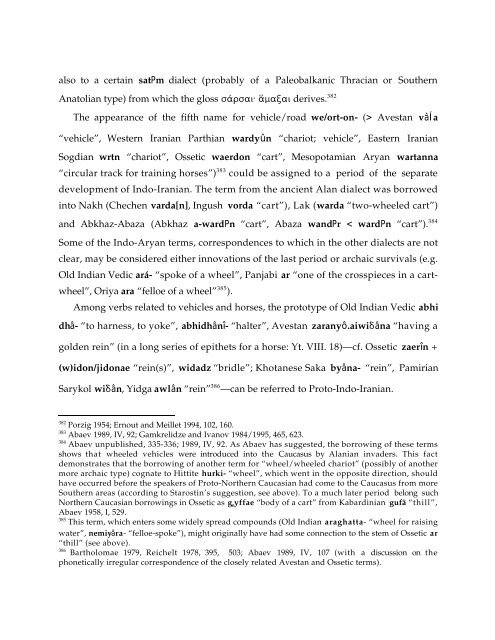Comparative Notes on Hurro-Urartian, Northern Caucasian
Comparative Notes on Hurro-Urartian, Northern Caucasian
Comparative Notes on Hurro-Urartian, Northern Caucasian
You also want an ePaper? Increase the reach of your titles
YUMPU automatically turns print PDFs into web optimized ePapers that Google loves.
also to a certain satPm dialect (probably of a Paleobalkanic Thracian or Southern<br />
Anatolian type) from which the gloss sãrsai: ëmajai derives. 382<br />
The appearance of the fifth name for vehicle/road we/ort-<strong>on</strong>- (> Avestan vâÍa<br />
“vehicle”, Western Iranian Parthian wardyûn “chariot; vehicle”, Eastern Iranian<br />
Sogdian wrtn “chariot”, Ossetic waerd<strong>on</strong> “cart”, Mesopotamian Aryan wartanna<br />
“circular track for training horses”) 383 could be assigned to a period of the separate<br />
development of Indo-Iranian. The term from the ancient Alan dialect was borrowed<br />
into Nakh (Chechen varda[n], Ingush vorda “cart”), Lak (warda “two-wheeled cart”)<br />
and Abkhaz-Abaza (Abkhaz a-wardPn “cart”, Abaza wandPr < wardPn “cart”). 384<br />
Some of the Indo-Aryan terms, corresp<strong>on</strong>dences to which in the other dialects are not<br />
clear, may be c<strong>on</strong>sidered either innovati<strong>on</strong>s of the last period or archaic survivals (e.g.<br />
Old Indian Vedic ará- “spoke of a wheel”, Panjabi ar “<strong>on</strong>e of the crosspieces in a cart-<br />
wheel”, Oriya ara “felloe of a wheel” 385 ).<br />
Am<strong>on</strong>g verbs related to vehicles and horses, the prototype of Old Indian Vedic abhi<br />
dhâ- “to harness, to yoke”, abhidhânî- “halter”, Avestan zaranyô.aiwidâna “having a<br />
golden rein” (in a l<strong>on</strong>g series of epithets for a horse: Yt. VIII. 18)—cf. Ossetic zaerîn +<br />
(w)id<strong>on</strong>/jid<strong>on</strong>ae “rein(s)”, widadz “bridle”; Khotanese Saka byâna- “rein”, Pamirian<br />
Sarykol widân, Yidga awlân “rein” 386 —can be referred to Proto-Indo-Iranian.<br />
382 Porzig 1954; Ernout and Meillet 1994, 102, 160.<br />
383 Abaev 1989, IV, 92; Gamkrelidze and Ivanov 1984/1995, 465, 623.<br />
384 Abaev unpublished, 335-336; 1989, IV, 92. As Abaev has suggested, the borrowing of these terms<br />
shows that wheeled vehicles were introduced into the Caucasus by Alanian invaders. This fact<br />
dem<strong>on</strong>strates that the borrowing of another term for “wheel/wheeled chariot” (possibly of another<br />
more archaic type) cognate to Hittite hurki- “wheel”, which went in the opposite directi<strong>on</strong>, should<br />
have occurred before the speakers of Proto-<strong>Northern</strong> <strong>Caucasian</strong> had come to the Caucasus from more<br />
Southern areas (according to Starostin’s suggesti<strong>on</strong>, see above). To a much later period bel<strong>on</strong>g such<br />
<strong>Northern</strong> <strong>Caucasian</strong> borrowings in Ossetic as g oyffae “body of a cart” from Kabardinian gufä “thill”,<br />
Abaev 1958, I, 529.<br />
385 This term, which enters some widely spread compounds (Old Indian araghatta- “wheel for raising<br />
water”, nemiyâra- “felloe-spoke”), might originally have had some c<strong>on</strong>necti<strong>on</strong> to the stem of Ossetic ar<br />
“thill” (see above).<br />
386 Bartholomae 1979, Reichelt 1978, 395, 503; Abaev 1989, IV, 107 (with a discussi<strong>on</strong> <strong>on</strong> the<br />
ph<strong>on</strong>etically irregular corresp<strong>on</strong>dence of the closely related Avestan and Ossetic terms).





